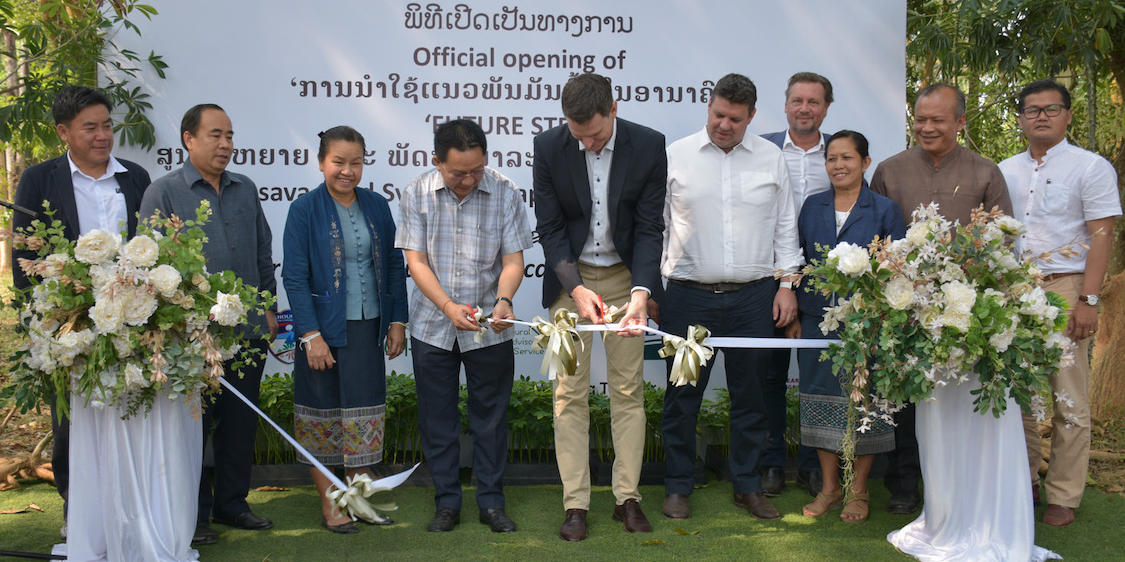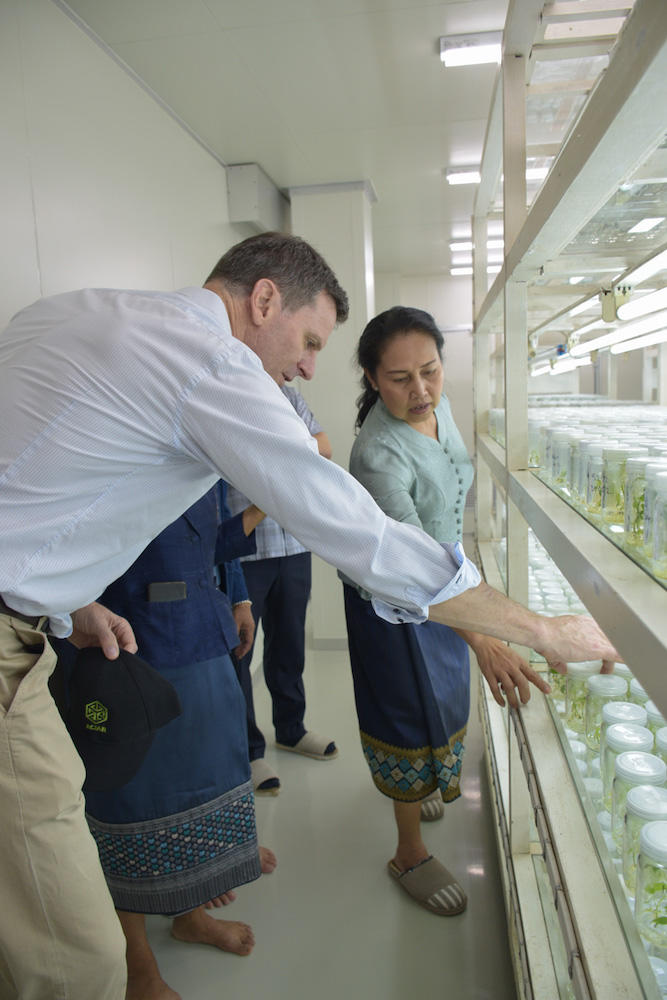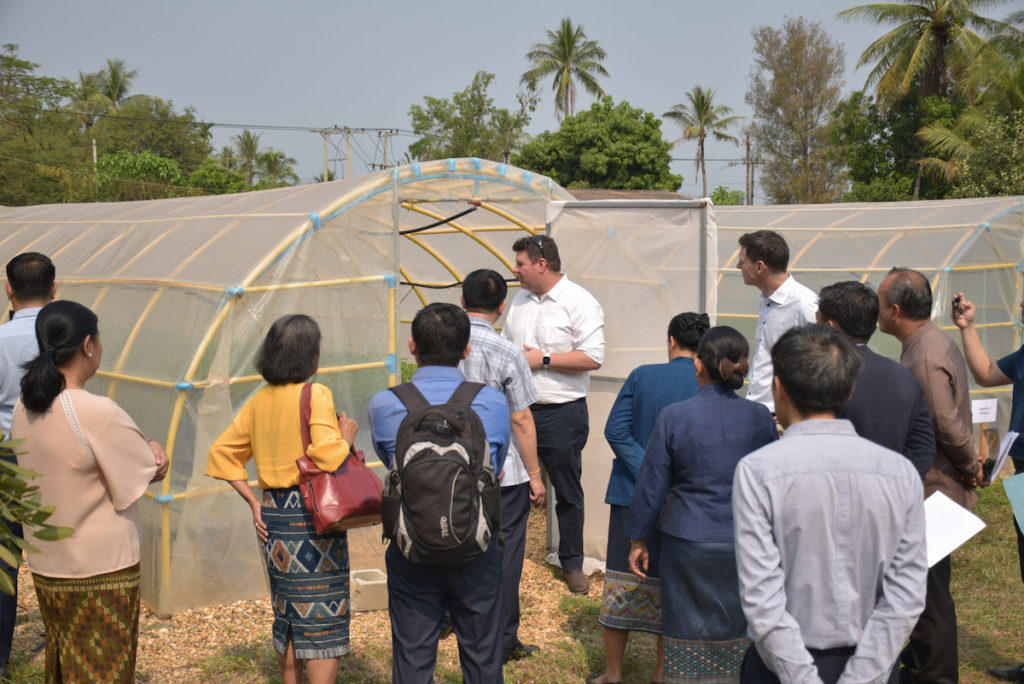Press and News Cassava program launches new facility in Laos

To combat the spread of pests and diseases in cassava, the Alliance of Bioversity International and CIAT have launched the first ever cassava stem multiplication center in Lao PDR, and the first tunnel-based rapid multiplication system in Asia. This is an important step in protecting the regional cassava industry, worth 225 million USD in Lao PDR alone, and multi-billion sector across Southeast Asia.
Cassava is one of the most important economic crops in Southeast Asia (SEA), with more than 2 million households in mainland SEA engaged in its production. In Lao PDR, cassava plantations cover more than 100,000 hectares (and growing steadily), bringing in more than US$225 million for smallholders in 2020 alone – behind only gold, copper, and bananas in overall national export value.
However, the industry faces an enormous challenge: the rapid regional spread of yield-limiting diseases. As Alliance regional cassava program leader Dr. Jonathan Newby explains,
“Cassava diseases such as Cassava Witches Broom Disease and Cassava Mosaic Disease threaten the livelihoods of millions of farmers in Asia, and a multibillion dollar and expanding industry. Unknown to most people, every day we eat or use something that includes cassava starch.”
Spread by flying insect pests and exchange of contaminated planting stems, these potentially devastating diseases risk cutting short Laos’ cassava honeymoon – unless methods are developed to mitigate their impact.
With the participation of Australian Ambassador to Lao PDR Paul Kelly, and Vice Minister of Agriculture and Forestry Linkham Douangsavanh, PhD, the Alliance of Bioversity International and CIAT spearheaded the launch of Future Stems, the first ever cassava stem multiplication center in the country on Friday, March 12, 2021.

All photos credit: ACIAR/Khounkham Douangphachone
“The Future Stems Centre is not just another typical infrastructure that Australia helped build. While located in a quiet part of Vientiane, the amazing scientific work that is being done in this facility and its field trial helps protect the incomes and livelihoods of millions of smallholders in our region as well as that of a multibillion-dollar industry,” said Mr. Kelly.
Future Stems was built in collaboration between the Alliance and the National Agriculture and Forestry, Research Institute (NAFRI) on a government research station in the Lao Capital. Stems produced here will supply clean starting materials for government and private sector actors who are building additional multiplication systems to produce clean planting material at sites around Lao PDR. This allows the Alliance and partners to rapidly produce and distribute disease-free planting materials and new varieties to stem multipliers and farmers—an important step to protect the cassava industry and safeguard smallholder livelihoods.

In addition to pests and diseases, one of the problems cassava has is a slow multiplication rate: one cassava plant can only produce about 10 stem cuttings per year, a multiplication rate of 1:10. This means it takes many years to multiply material, leading to long delays and more risk of re-infection to reach the millions of hectares of cassava in Southeast Asia. With the Alliance system operating at the Future Stems center, this rate can be massively increased to 1:125 – allowing researchers to produce much more clean planting material faster and cleaner than with the conventional system.
During the launch event, the Alliance also hosted Lao district agriculture officials, NGO staff, and research organization members for 2 days of training on cassava planting, sustainable management, and pest and disease issues. The event was also an opportunity to screen several educational videos recently developed by the Alliance Asia cassava program together with the Lao Uplands Rural Advisory Service on cassava mosaic disease and how to build a stem multiplication tunnel.
This activity is one of the initiatives under the project “Establishing sustainable solutions to cassava diseases in mainland Southeast Asia,” an Alliance-run, Australian Center for International Agricultural Research funded project that started in 2019. The work in this project involves a multi-pronged strategy covering breeding, surveillance, agronomy, and seed systems interventions and coordinates with governments and agribusinesses in 4 Southeast Asian countries to develop sustainable solutions to looming pest and disease problems.

Partnerships are key to allow the project to reach its potential impact. Linkages in Lao PDR so far include cooperation with USDA, Winrock International, and the Lao Department of Agriculture through the CLEAN project, cooperation on farmer training with SDC-Helvetas through the LURAS project and Lux-Development, and private sector partnerships with cassava industry actors such as Khounsub import-export company in Champassak, Southern Laos, where 10 additional tunnels have been built and are already producing stems.
“Establishing Future Stems will help the government of Laos and the cassava industry to respond to future outbreaks of CMD and address other disease problems,” said Vice Minister Linkham at the launch event.
“Access to clean planting material in the short term, and the multiplication of disease resistant varieties in the medium term will help ensure both farmers and industry can capitalize on the growing global market for cassava-based products. I believe the future remains very bright for the cassava sector in Laos. The Ministry of Agriculture is committed to working with all partners in ensuring that this future becomes a reality.”
